Business Law Report: Analysis of Legal System and its Business Impact
VerifiedAdded on 2024/04/26
|23
|3852
|182
Report
AI Summary
This report provides a comprehensive analysis of the English Legal System, including its structure, the roles of administrative departments, and key legal principles like common law and stare decisis. It details the hierarchy of courts from the Supreme Court to Magistrate Courts, and explains the roles of solicitors, barristers, and judges. The report also covers the legislative process, from drafting a bill to royal assent, and discusses recent reforms in the English Legal System. Furthermore, it examines the impact of law on business organizations, focusing on occupational health and safety, workers' compensation, harassment, and equal opportunities, with a case study involving a workplace accident. The report also addresses unfair dismissal and misrepresentation with relevant case scenarios, providing potential legal challenges and outcomes. Finally, it recommends appropriate legal solutions based on alternative legal advice.
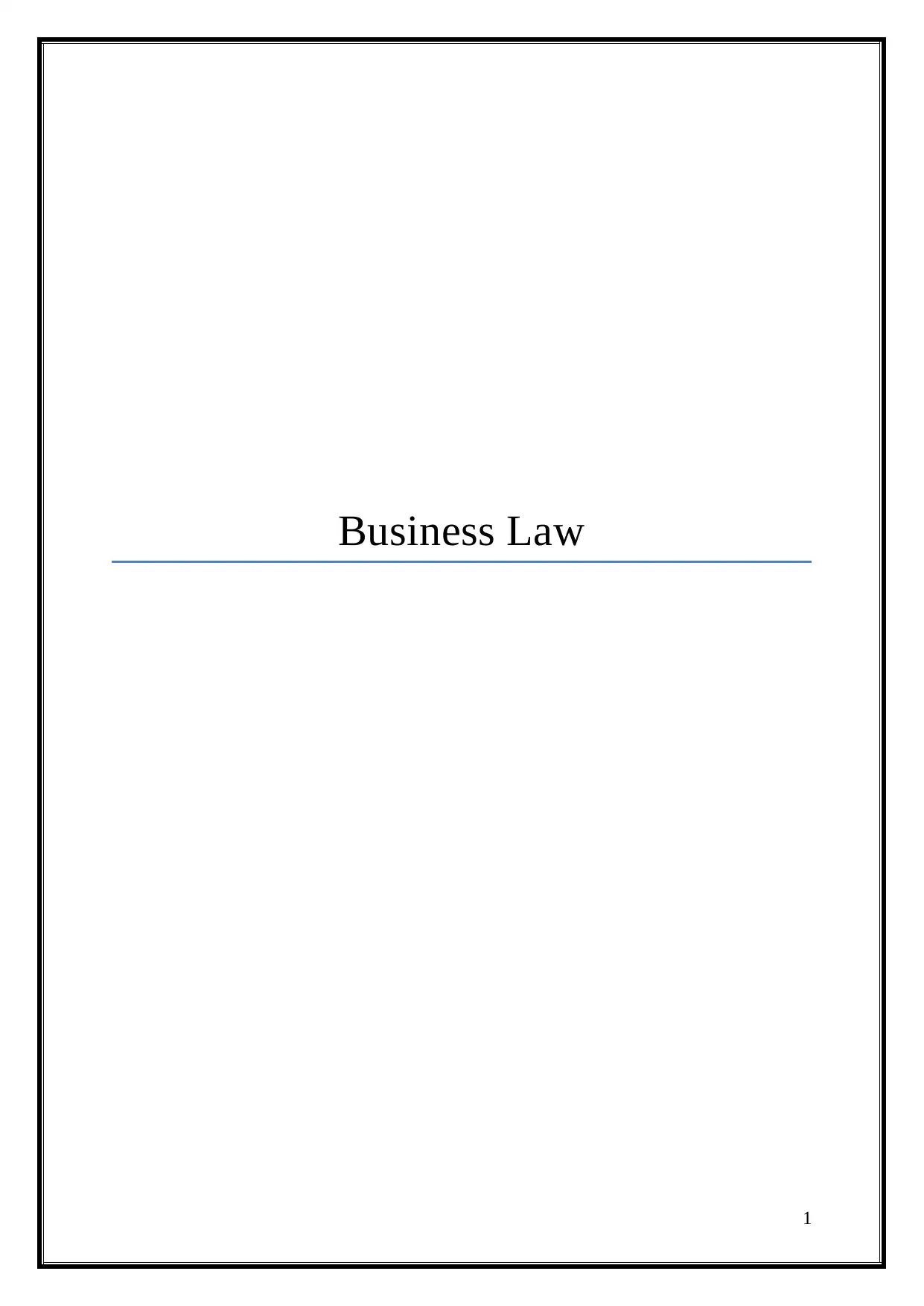
Business Law
1
1
Paraphrase This Document
Need a fresh take? Get an instant paraphrase of this document with our AI Paraphraser
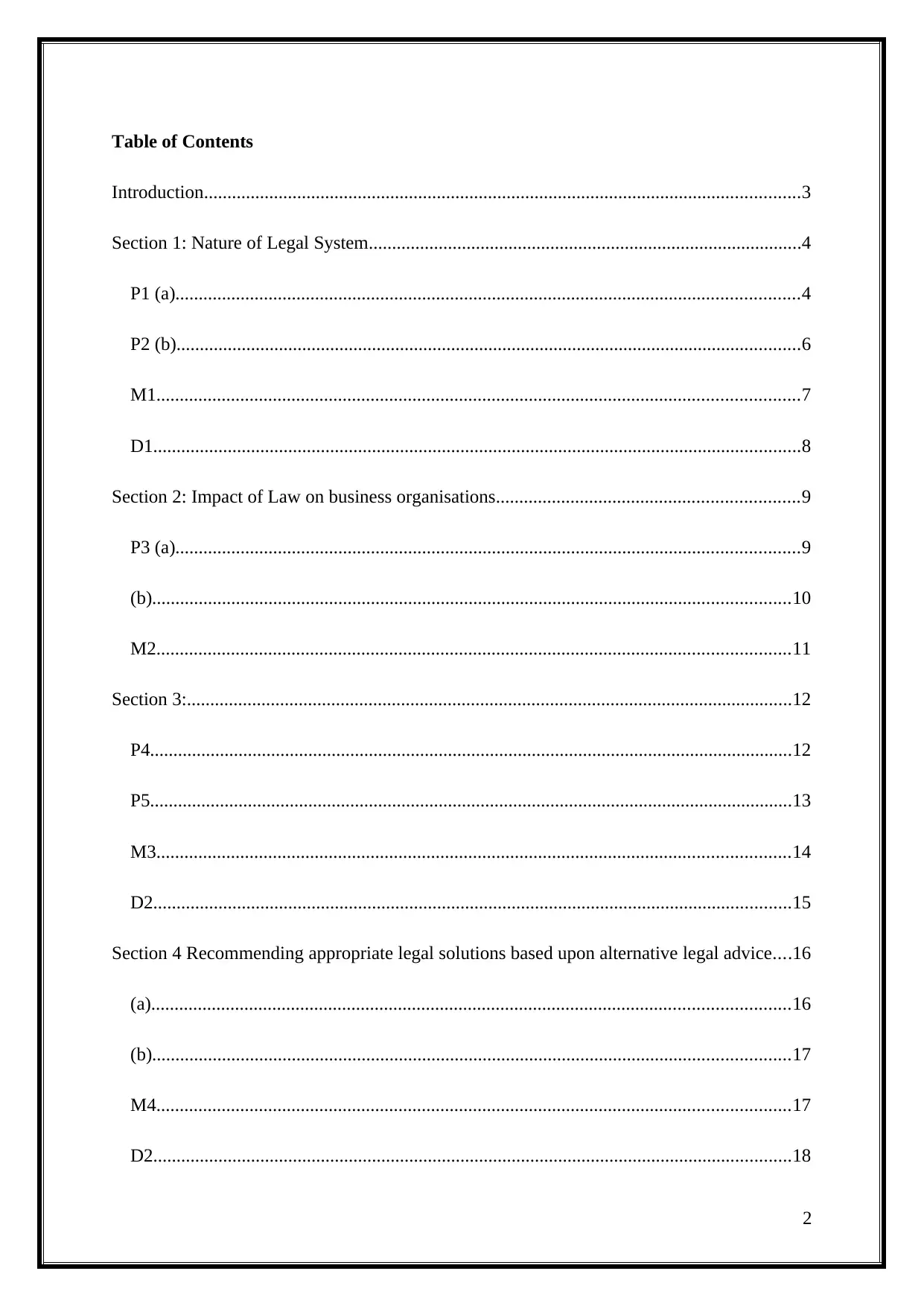
Table of Contents
Introduction................................................................................................................................3
Section 1: Nature of Legal System.............................................................................................4
P1 (a)......................................................................................................................................4
P2 (b)......................................................................................................................................6
M1..........................................................................................................................................7
D1...........................................................................................................................................8
Section 2: Impact of Law on business organisations.................................................................9
P3 (a)......................................................................................................................................9
(b).........................................................................................................................................10
M2........................................................................................................................................11
Section 3:..................................................................................................................................12
P4..........................................................................................................................................12
P5..........................................................................................................................................13
M3........................................................................................................................................14
D2.........................................................................................................................................15
Section 4 Recommending appropriate legal solutions based upon alternative legal advice....16
(a).........................................................................................................................................16
(b).........................................................................................................................................17
M4........................................................................................................................................17
D2.........................................................................................................................................18
2
Introduction................................................................................................................................3
Section 1: Nature of Legal System.............................................................................................4
P1 (a)......................................................................................................................................4
P2 (b)......................................................................................................................................6
M1..........................................................................................................................................7
D1...........................................................................................................................................8
Section 2: Impact of Law on business organisations.................................................................9
P3 (a)......................................................................................................................................9
(b).........................................................................................................................................10
M2........................................................................................................................................11
Section 3:..................................................................................................................................12
P4..........................................................................................................................................12
P5..........................................................................................................................................13
M3........................................................................................................................................14
D2.........................................................................................................................................15
Section 4 Recommending appropriate legal solutions based upon alternative legal advice....16
(a).........................................................................................................................................16
(b).........................................................................................................................................17
M4........................................................................................................................................17
D2.........................................................................................................................................18
2
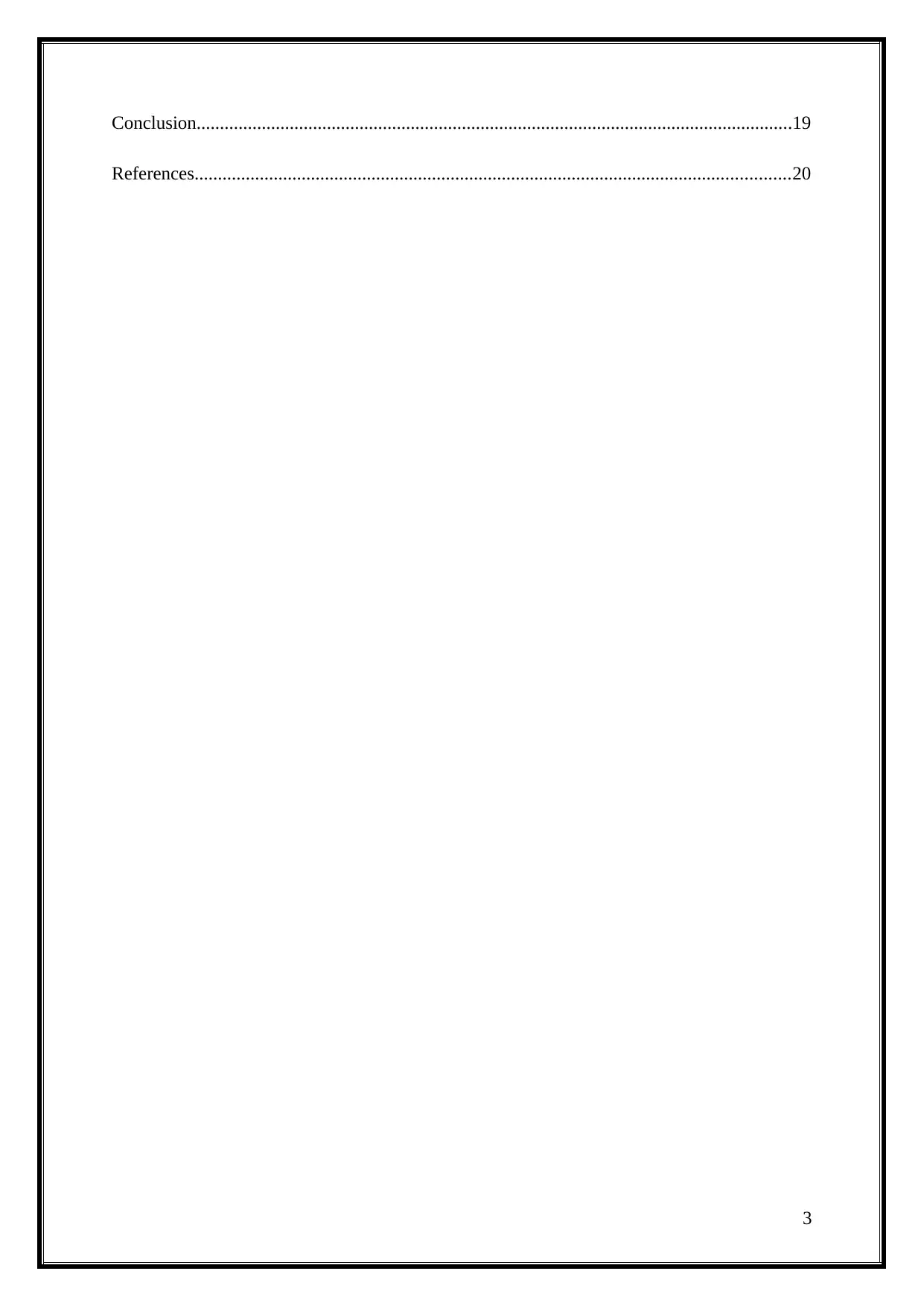
Conclusion................................................................................................................................19
References................................................................................................................................20
3
References................................................................................................................................20
3
⊘ This is a preview!⊘
Do you want full access?
Subscribe today to unlock all pages.

Trusted by 1+ million students worldwide
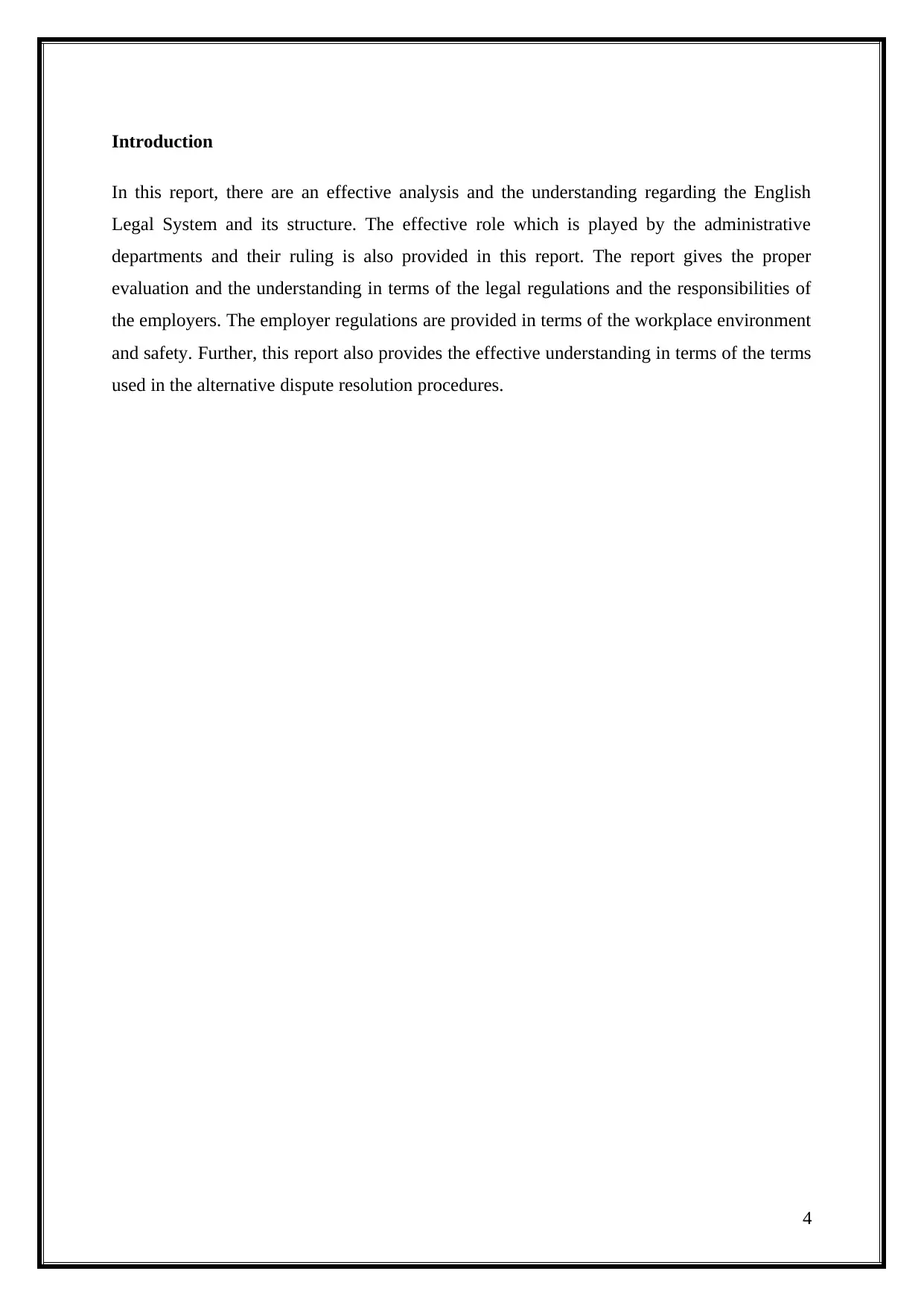
Introduction
In this report, there are an effective analysis and the understanding regarding the English
Legal System and its structure. The effective role which is played by the administrative
departments and their ruling is also provided in this report. The report gives the proper
evaluation and the understanding in terms of the legal regulations and the responsibilities of
the employers. The employer regulations are provided in terms of the workplace environment
and safety. Further, this report also provides the effective understanding in terms of the terms
used in the alternative dispute resolution procedures.
4
In this report, there are an effective analysis and the understanding regarding the English
Legal System and its structure. The effective role which is played by the administrative
departments and their ruling is also provided in this report. The report gives the proper
evaluation and the understanding in terms of the legal regulations and the responsibilities of
the employers. The employer regulations are provided in terms of the workplace environment
and safety. Further, this report also provides the effective understanding in terms of the terms
used in the alternative dispute resolution procedures.
4
Paraphrase This Document
Need a fresh take? Get an instant paraphrase of this document with our AI Paraphraser

Section 1: Nature of Legal System
P1 (a)
The English Legal System is considered as one of the oldest legal systems which operate in
the United Kingdom. The working of the legal system is based on the principles which are
headed under the principles of common law. The hierarchy which is followed under this
system is presented thereunder:
Supreme Court: The Supreme Court is considered to be higher authority under this system.
The other subordinate court work under the Supreme Court and the matters which are not
solved are also headed by the Supreme Court.
Court of Appeal: The court of appeal is headed by both divisions of court (civil and
criminal). In this court, the matters which are referred in by the high court are solved under
this. Herein the civil division is responsible for the matters other than the criminal while
criminal division solves such matter.
High Court: The working of the High court is under the Court of Appeal. The divisions or
subheads which work under it are Queen’s Bench, Family and Chancery Courts.
Crown Court: This court deals with such cases which are of criminal nature. Further, the
matters which are appealed to it from the lower courts are handled by this court (Allen,
2015).
Magistrate Courts: It is responsible for dealing with such cases which are related to the
public and such cases which are dealt in by the crown court.
Role of Solicitors, Barristers and Judges:
Professionals Role
Solicitors Solicitors are considered to be professionals who are responsible for
advising the clients. It is also considered to be responsible for the
appointment of the barristers.
5
P1 (a)
The English Legal System is considered as one of the oldest legal systems which operate in
the United Kingdom. The working of the legal system is based on the principles which are
headed under the principles of common law. The hierarchy which is followed under this
system is presented thereunder:
Supreme Court: The Supreme Court is considered to be higher authority under this system.
The other subordinate court work under the Supreme Court and the matters which are not
solved are also headed by the Supreme Court.
Court of Appeal: The court of appeal is headed by both divisions of court (civil and
criminal). In this court, the matters which are referred in by the high court are solved under
this. Herein the civil division is responsible for the matters other than the criminal while
criminal division solves such matter.
High Court: The working of the High court is under the Court of Appeal. The divisions or
subheads which work under it are Queen’s Bench, Family and Chancery Courts.
Crown Court: This court deals with such cases which are of criminal nature. Further, the
matters which are appealed to it from the lower courts are handled by this court (Allen,
2015).
Magistrate Courts: It is responsible for dealing with such cases which are related to the
public and such cases which are dealt in by the crown court.
Role of Solicitors, Barristers and Judges:
Professionals Role
Solicitors Solicitors are considered to be professionals who are responsible for
advising the clients. It is also considered to be responsible for the
appointment of the barristers.
5
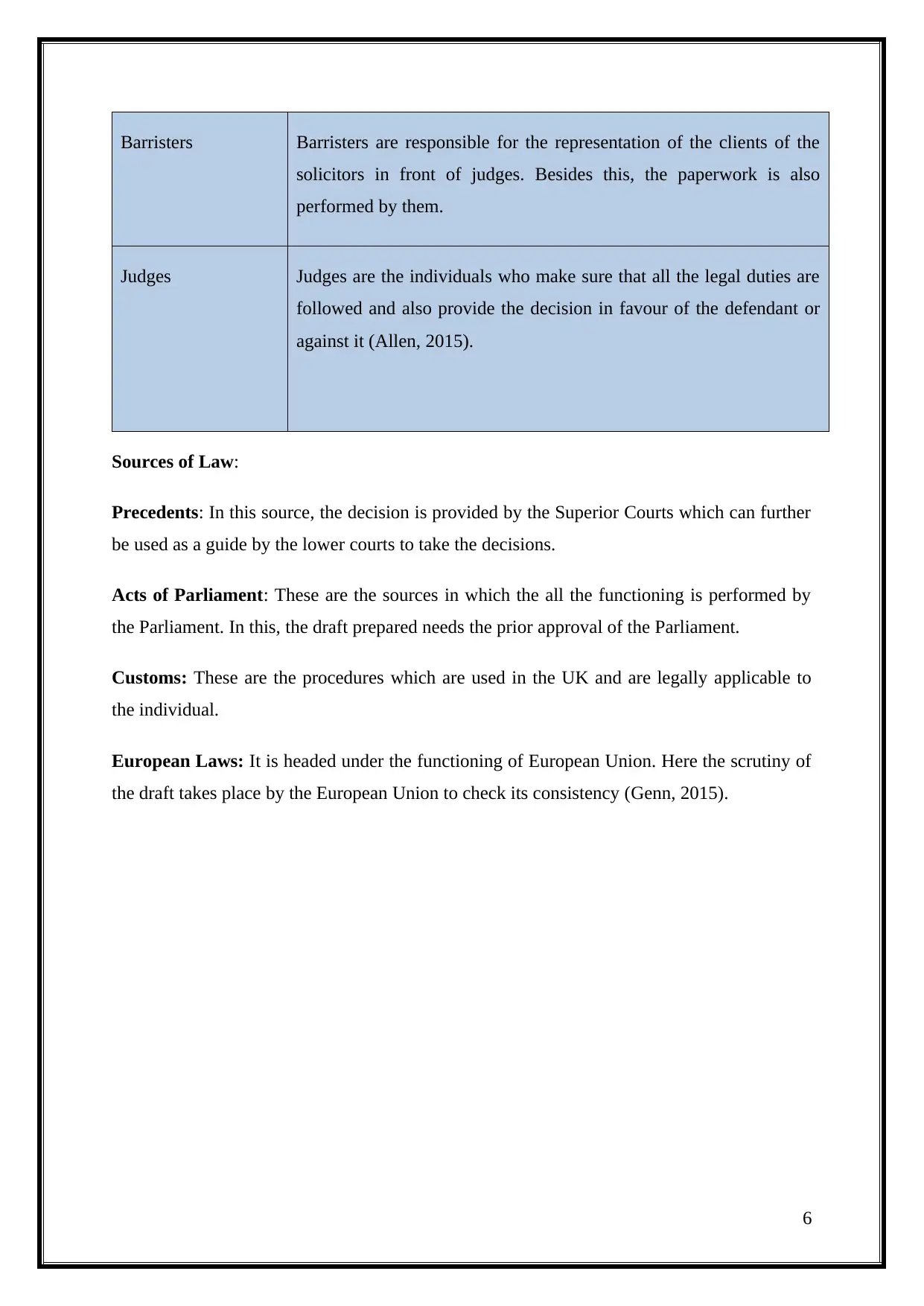
Barristers Barristers are responsible for the representation of the clients of the
solicitors in front of judges. Besides this, the paperwork is also
performed by them.
Judges Judges are the individuals who make sure that all the legal duties are
followed and also provide the decision in favour of the defendant or
against it (Allen, 2015).
Sources of Law:
Precedents: In this source, the decision is provided by the Superior Courts which can further
be used as a guide by the lower courts to take the decisions.
Acts of Parliament: These are the sources in which the all the functioning is performed by
the Parliament. In this, the draft prepared needs the prior approval of the Parliament.
Customs: These are the procedures which are used in the UK and are legally applicable to
the individual.
European Laws: It is headed under the functioning of European Union. Here the scrutiny of
the draft takes place by the European Union to check its consistency (Genn, 2015).
6
solicitors in front of judges. Besides this, the paperwork is also
performed by them.
Judges Judges are the individuals who make sure that all the legal duties are
followed and also provide the decision in favour of the defendant or
against it (Allen, 2015).
Sources of Law:
Precedents: In this source, the decision is provided by the Superior Courts which can further
be used as a guide by the lower courts to take the decisions.
Acts of Parliament: These are the sources in which the all the functioning is performed by
the Parliament. In this, the draft prepared needs the prior approval of the Parliament.
Customs: These are the procedures which are used in the UK and are legally applicable to
the individual.
European Laws: It is headed under the functioning of European Union. Here the scrutiny of
the draft takes place by the European Union to check its consistency (Genn, 2015).
6
⊘ This is a preview!⊘
Do you want full access?
Subscribe today to unlock all pages.

Trusted by 1+ million students worldwide
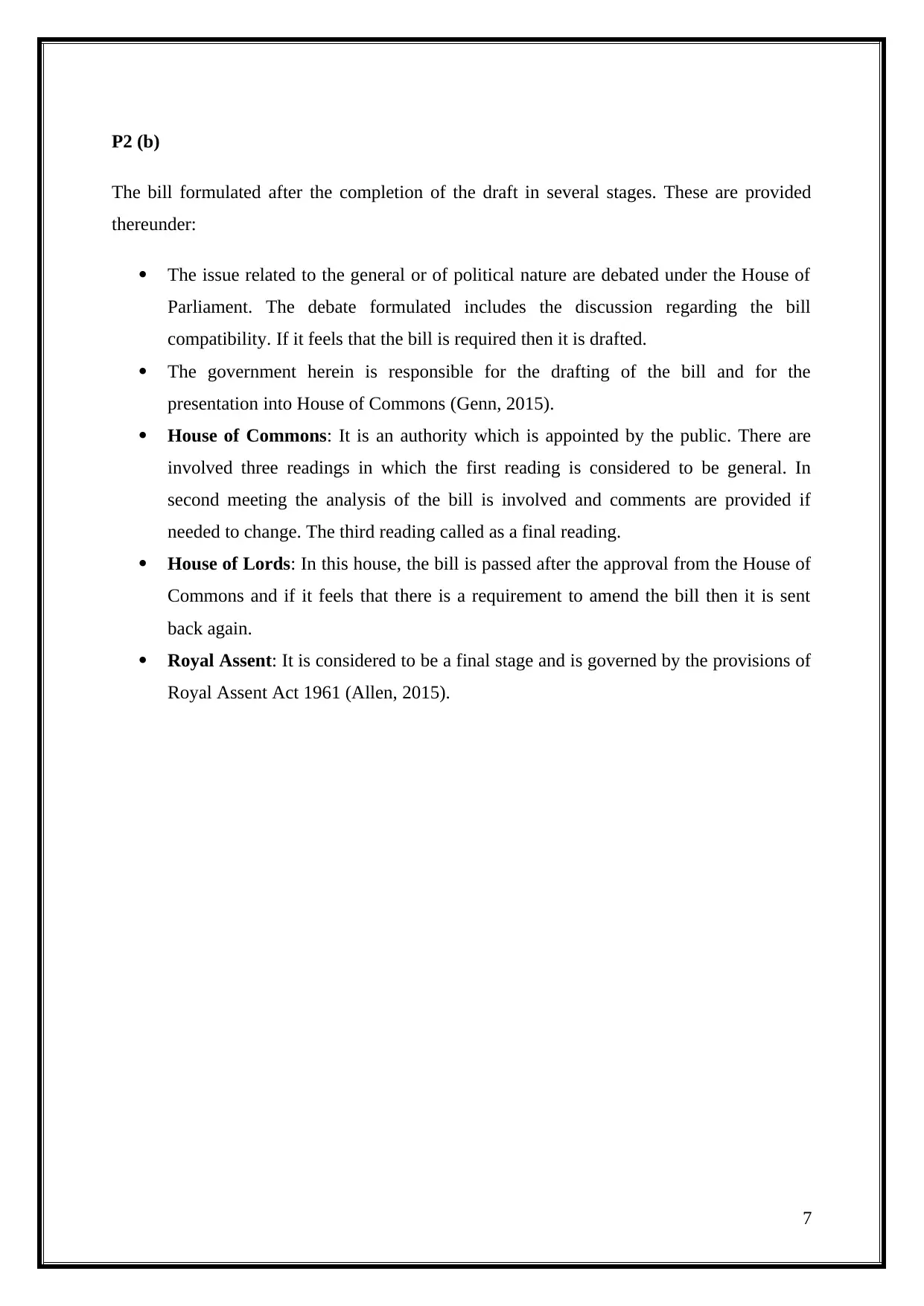
P2 (b)
The bill formulated after the completion of the draft in several stages. These are provided
thereunder:
The issue related to the general or of political nature are debated under the House of
Parliament. The debate formulated includes the discussion regarding the bill
compatibility. If it feels that the bill is required then it is drafted.
The government herein is responsible for the drafting of the bill and for the
presentation into House of Commons (Genn, 2015).
House of Commons: It is an authority which is appointed by the public. There are
involved three readings in which the first reading is considered to be general. In
second meeting the analysis of the bill is involved and comments are provided if
needed to change. The third reading called as a final reading.
House of Lords: In this house, the bill is passed after the approval from the House of
Commons and if it feels that there is a requirement to amend the bill then it is sent
back again.
Royal Assent: It is considered to be a final stage and is governed by the provisions of
Royal Assent Act 1961 (Allen, 2015).
7
The bill formulated after the completion of the draft in several stages. These are provided
thereunder:
The issue related to the general or of political nature are debated under the House of
Parliament. The debate formulated includes the discussion regarding the bill
compatibility. If it feels that the bill is required then it is drafted.
The government herein is responsible for the drafting of the bill and for the
presentation into House of Commons (Genn, 2015).
House of Commons: It is an authority which is appointed by the public. There are
involved three readings in which the first reading is considered to be general. In
second meeting the analysis of the bill is involved and comments are provided if
needed to change. The third reading called as a final reading.
House of Lords: In this house, the bill is passed after the approval from the House of
Commons and if it feels that there is a requirement to amend the bill then it is sent
back again.
Royal Assent: It is considered to be a final stage and is governed by the provisions of
Royal Assent Act 1961 (Allen, 2015).
7
Paraphrase This Document
Need a fresh take? Get an instant paraphrase of this document with our AI Paraphraser
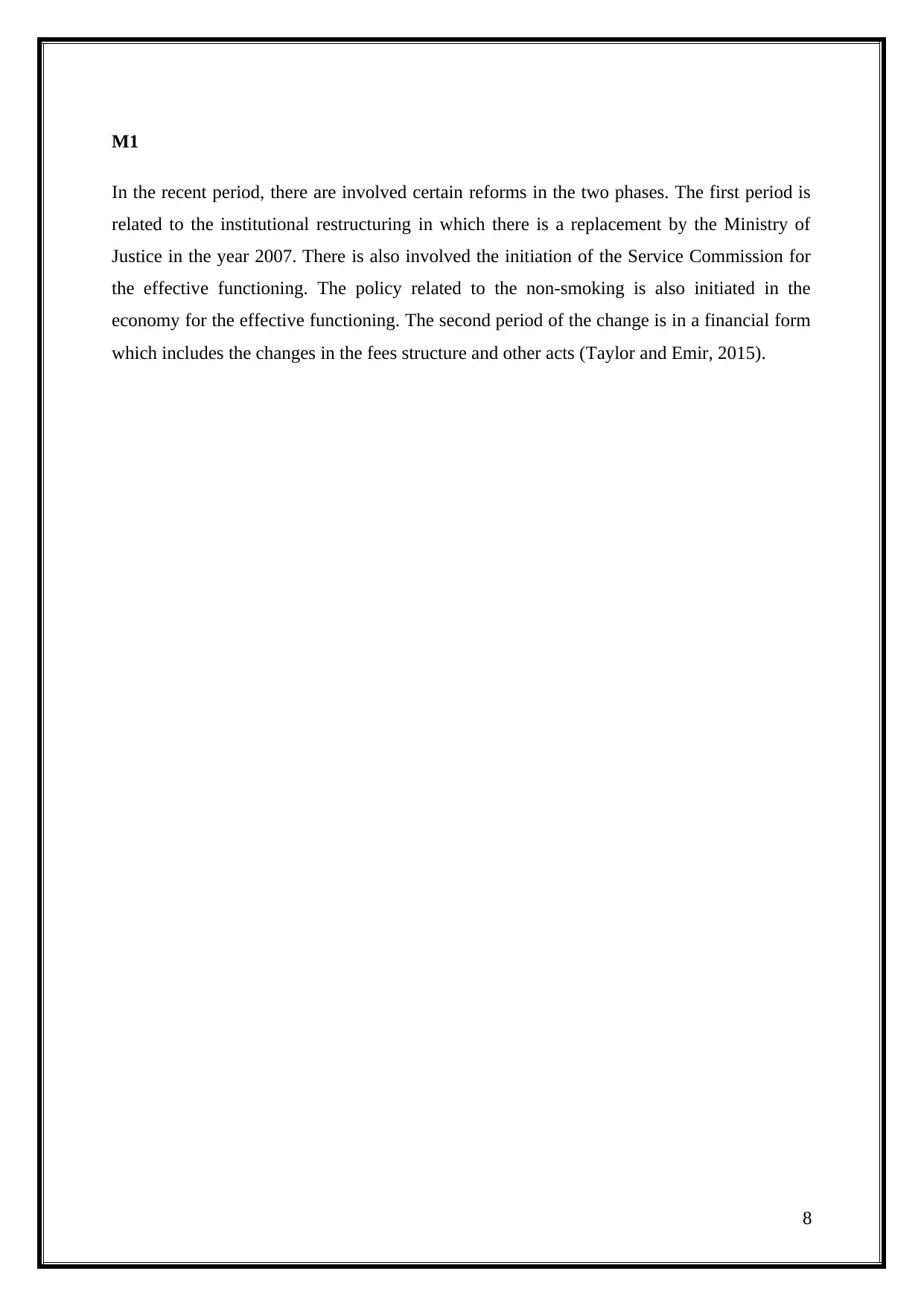
M1
In the recent period, there are involved certain reforms in the two phases. The first period is
related to the institutional restructuring in which there is a replacement by the Ministry of
Justice in the year 2007. There is also involved the initiation of the Service Commission for
the effective functioning. The policy related to the non-smoking is also initiated in the
economy for the effective functioning. The second period of the change is in a financial form
which includes the changes in the fees structure and other acts (Taylor and Emir, 2015).
8
In the recent period, there are involved certain reforms in the two phases. The first period is
related to the institutional restructuring in which there is a replacement by the Ministry of
Justice in the year 2007. There is also involved the initiation of the Service Commission for
the effective functioning. The policy related to the non-smoking is also initiated in the
economy for the effective functioning. The second period of the change is in a financial form
which includes the changes in the fees structure and other acts (Taylor and Emir, 2015).
8
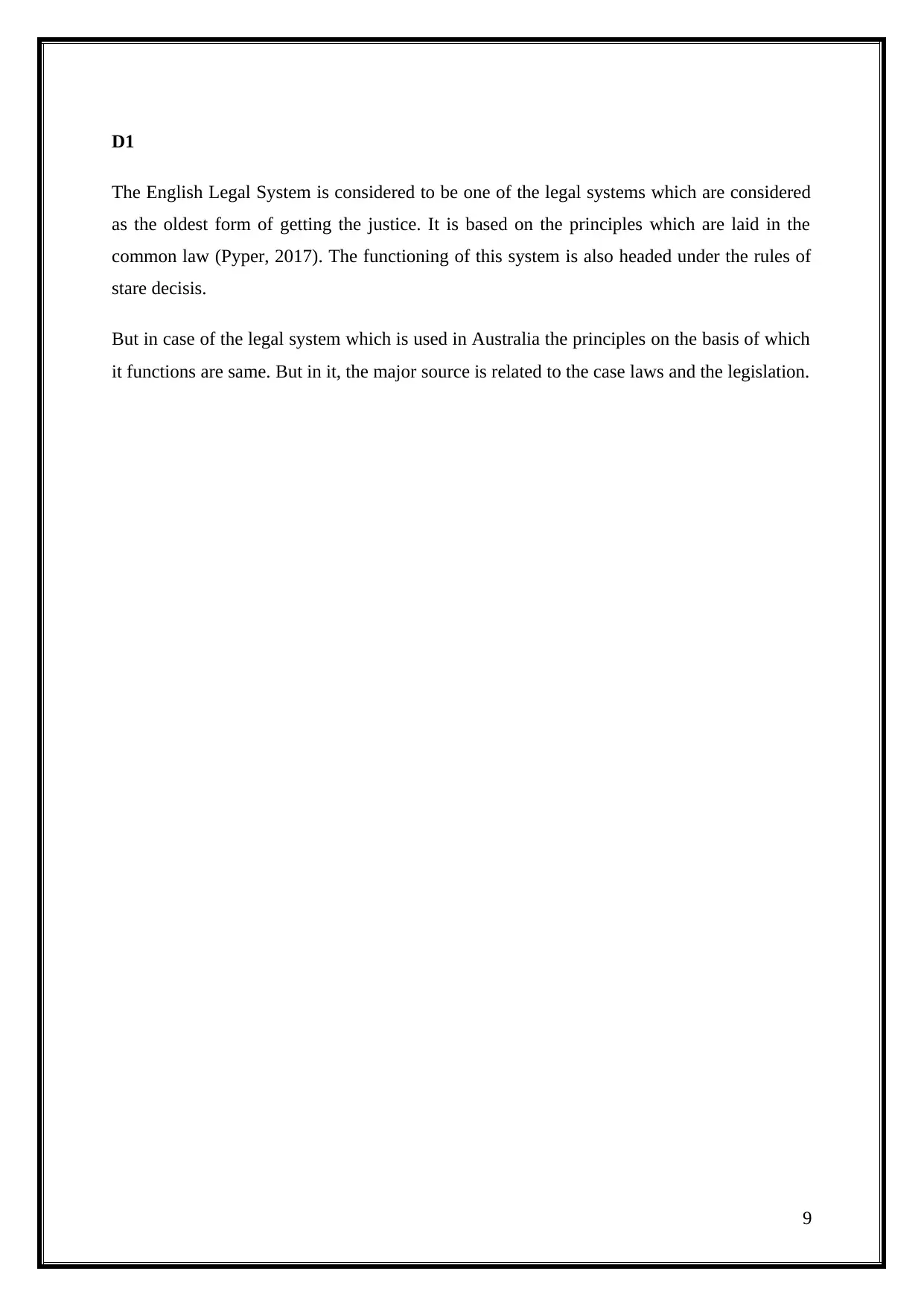
D1
The English Legal System is considered to be one of the legal systems which are considered
as the oldest form of getting the justice. It is based on the principles which are laid in the
common law (Pyper, 2017). The functioning of this system is also headed under the rules of
stare decisis.
But in case of the legal system which is used in Australia the principles on the basis of which
it functions are same. But in it, the major source is related to the case laws and the legislation.
9
The English Legal System is considered to be one of the legal systems which are considered
as the oldest form of getting the justice. It is based on the principles which are laid in the
common law (Pyper, 2017). The functioning of this system is also headed under the rules of
stare decisis.
But in case of the legal system which is used in Australia the principles on the basis of which
it functions are same. But in it, the major source is related to the case laws and the legislation.
9
⊘ This is a preview!⊘
Do you want full access?
Subscribe today to unlock all pages.

Trusted by 1+ million students worldwide

Section 2: Impact of Law on business organisations
P3 (a)
(i) Occupational Health and Safety: The provisions of the health and safety at the
workplace are governed under the standards of Occupational Health and Safety Act 1970.
This act binds the employer to provide an effective environment to the workers at the
workplace. Effective arrangements related to the risks assessment and training is involved at
the workplace to minimize the number of accidents.
(ii) Workers Compensation: The compensation which is provided to the workers is
considered as a part of the reimbursement expenses which are paid by the employer to his
employee on the grounds of accident involved in the workplace. Hence the compensation is
considered as a part of the liability for the employer (Bclaws, 2017).
(iii) Harassments: The provisions related to the Equality Act guides the working of the
individual to provide such environment which is considered to be appropriate for the
working. Hence all the responsibility is on the part of the employer to provide effective
practices and the work environment (Gowland, 2013).
(iv) Equal Opportunities: Equality is considered to be one of the effective practices which
are followed in the workplace. All the employees should be treated equally in the workplace
and no discrimination should be involved among them. The disability is also not considered
to be an effective ground for the purpose of the discrimination.
10
P3 (a)
(i) Occupational Health and Safety: The provisions of the health and safety at the
workplace are governed under the standards of Occupational Health and Safety Act 1970.
This act binds the employer to provide an effective environment to the workers at the
workplace. Effective arrangements related to the risks assessment and training is involved at
the workplace to minimize the number of accidents.
(ii) Workers Compensation: The compensation which is provided to the workers is
considered as a part of the reimbursement expenses which are paid by the employer to his
employee on the grounds of accident involved in the workplace. Hence the compensation is
considered as a part of the liability for the employer (Bclaws, 2017).
(iii) Harassments: The provisions related to the Equality Act guides the working of the
individual to provide such environment which is considered to be appropriate for the
working. Hence all the responsibility is on the part of the employer to provide effective
practices and the work environment (Gowland, 2013).
(iv) Equal Opportunities: Equality is considered to be one of the effective practices which
are followed in the workplace. All the employees should be treated equally in the workplace
and no discrimination should be involved among them. The disability is also not considered
to be an effective ground for the purpose of the discrimination.
10
Paraphrase This Document
Need a fresh take? Get an instant paraphrase of this document with our AI Paraphraser
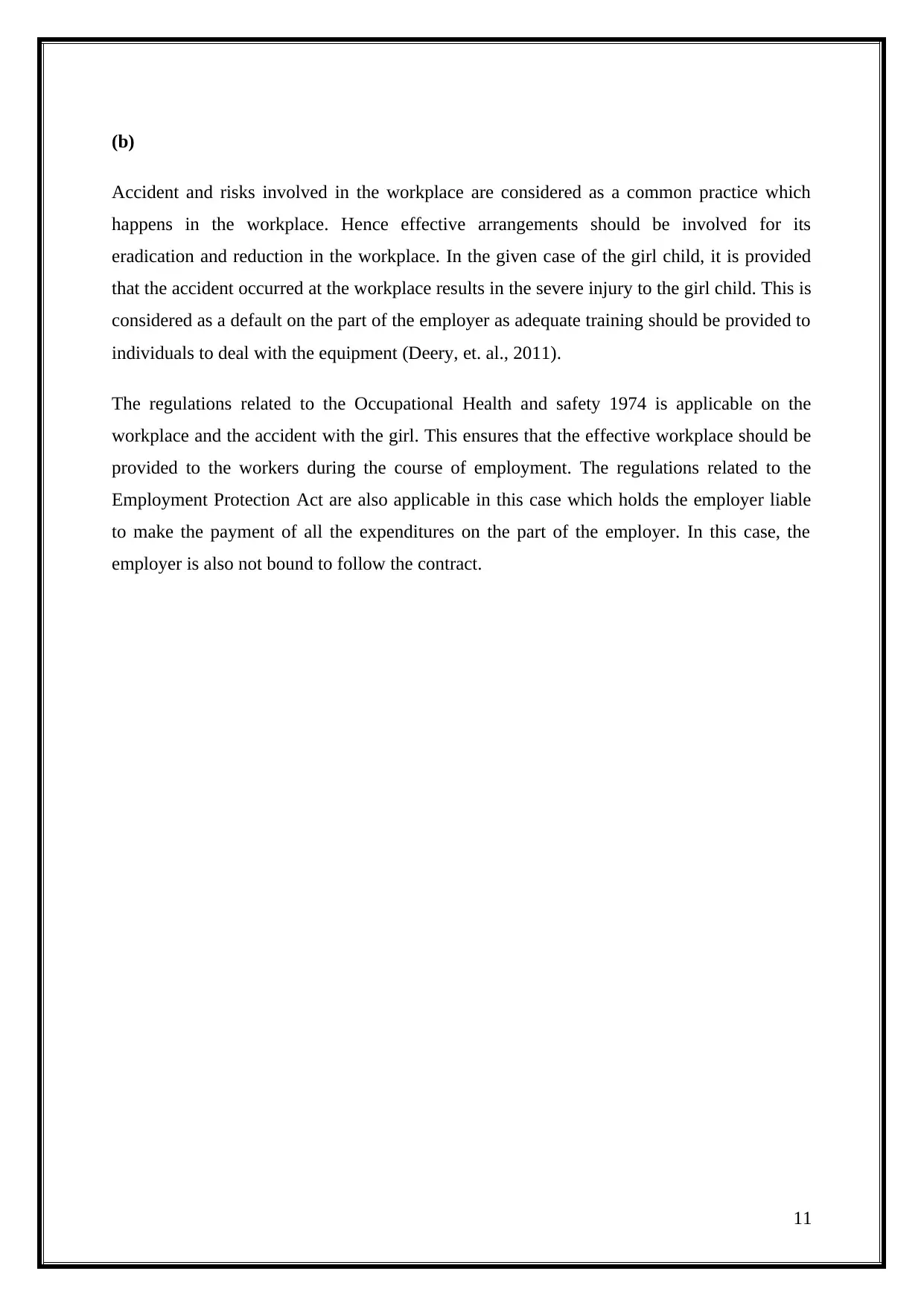
(b)
Accident and risks involved in the workplace are considered as a common practice which
happens in the workplace. Hence effective arrangements should be involved for its
eradication and reduction in the workplace. In the given case of the girl child, it is provided
that the accident occurred at the workplace results in the severe injury to the girl child. This is
considered as a default on the part of the employer as adequate training should be provided to
individuals to deal with the equipment (Deery, et. al., 2011).
The regulations related to the Occupational Health and safety 1974 is applicable on the
workplace and the accident with the girl. This ensures that the effective workplace should be
provided to the workers during the course of employment. The regulations related to the
Employment Protection Act are also applicable in this case which holds the employer liable
to make the payment of all the expenditures on the part of the employer. In this case, the
employer is also not bound to follow the contract.
11
Accident and risks involved in the workplace are considered as a common practice which
happens in the workplace. Hence effective arrangements should be involved for its
eradication and reduction in the workplace. In the given case of the girl child, it is provided
that the accident occurred at the workplace results in the severe injury to the girl child. This is
considered as a default on the part of the employer as adequate training should be provided to
individuals to deal with the equipment (Deery, et. al., 2011).
The regulations related to the Occupational Health and safety 1974 is applicable on the
workplace and the accident with the girl. This ensures that the effective workplace should be
provided to the workers during the course of employment. The regulations related to the
Employment Protection Act are also applicable in this case which holds the employer liable
to make the payment of all the expenditures on the part of the employer. In this case, the
employer is also not bound to follow the contract.
11
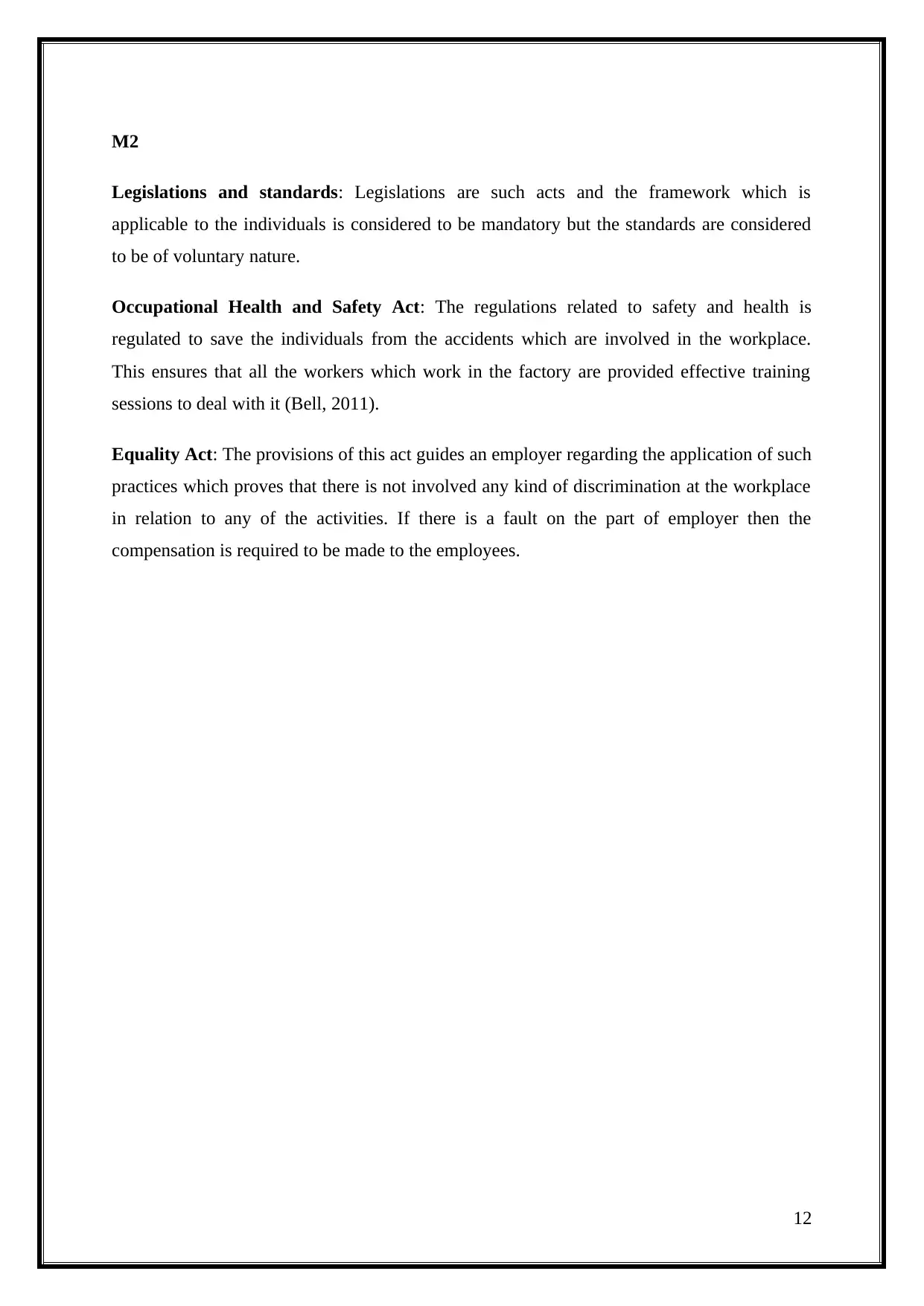
M2
Legislations and standards: Legislations are such acts and the framework which is
applicable to the individuals is considered to be mandatory but the standards are considered
to be of voluntary nature.
Occupational Health and Safety Act: The regulations related to safety and health is
regulated to save the individuals from the accidents which are involved in the workplace.
This ensures that all the workers which work in the factory are provided effective training
sessions to deal with it (Bell, 2011).
Equality Act: The provisions of this act guides an employer regarding the application of such
practices which proves that there is not involved any kind of discrimination at the workplace
in relation to any of the activities. If there is a fault on the part of employer then the
compensation is required to be made to the employees.
12
Legislations and standards: Legislations are such acts and the framework which is
applicable to the individuals is considered to be mandatory but the standards are considered
to be of voluntary nature.
Occupational Health and Safety Act: The regulations related to safety and health is
regulated to save the individuals from the accidents which are involved in the workplace.
This ensures that all the workers which work in the factory are provided effective training
sessions to deal with it (Bell, 2011).
Equality Act: The provisions of this act guides an employer regarding the application of such
practices which proves that there is not involved any kind of discrimination at the workplace
in relation to any of the activities. If there is a fault on the part of employer then the
compensation is required to be made to the employees.
12
⊘ This is a preview!⊘
Do you want full access?
Subscribe today to unlock all pages.

Trusted by 1+ million students worldwide
1 out of 23
Related Documents
Your All-in-One AI-Powered Toolkit for Academic Success.
+13062052269
info@desklib.com
Available 24*7 on WhatsApp / Email
![[object Object]](/_next/static/media/star-bottom.7253800d.svg)
Unlock your academic potential
Copyright © 2020–2025 A2Z Services. All Rights Reserved. Developed and managed by ZUCOL.





